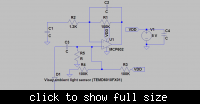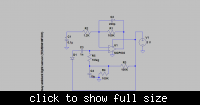aamit4
Newbie level 5
Hello,
I am trying to build phototdetector circuit that would detect blinking LED, that's the data. I am using ambient light sensor from Visay (TEMD6010FX01)and MCP602 single supply op-amp. My circuit would work without biasing non-inverting(+) pin such as at mid-supply (2.5V). But, when i biased it with 2.5V using voltage divider, op amp would saturate, i would see straight line at 5V on oscilloscope. Also, how do i determine the correct value for coupling capacitor (C3) and bypass capacitor (C1), feedback C2. Also, do i need to put connect resistor from + pin to ground. i have attached an image on my circuit Can anyone help me please? Thank you in advance.

I am trying to build phototdetector circuit that would detect blinking LED, that's the data. I am using ambient light sensor from Visay (TEMD6010FX01)and MCP602 single supply op-amp. My circuit would work without biasing non-inverting(+) pin such as at mid-supply (2.5V). But, when i biased it with 2.5V using voltage divider, op amp would saturate, i would see straight line at 5V on oscilloscope. Also, how do i determine the correct value for coupling capacitor (C3) and bypass capacitor (C1), feedback C2. Also, do i need to put connect resistor from + pin to ground. i have attached an image on my circuit Can anyone help me please? Thank you in advance.

